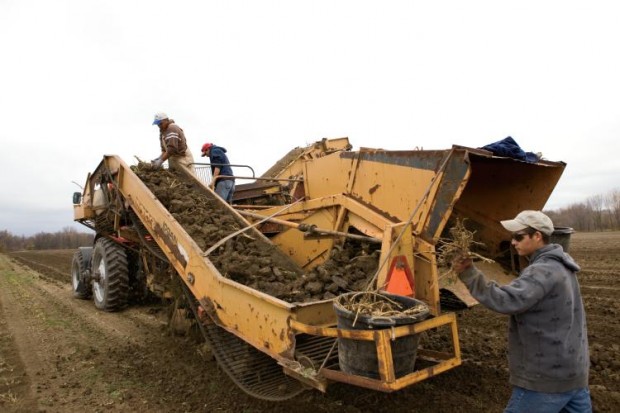Southwest Illinois: Horseradish Capital of America
By Martin Ross |Americans today like a little burn in their burrito, a wasabi wallop with their sushi, a chili charge in their Thai takeout.
And as long as consumers yearn for the burn, Southern Illinois horseradish grower Jeff Heepke will bring the heat.
Horseradish has held its own in a fickle culinary environment, gracing prime rib, shrimp dips, holiday tables and a growing list of saucy formulations designed to tantalize adventurous taste buds. In fact, the International Herb Association crowned horseradish the 2011 Herb of the Year, citing its rich historical roots and diversity – Armoracia rusticana, as it’s known in the botanical world, has also served a variety of chemical and medical uses. [Related: Horseradish History and Other Pungent Particulars]

Nationwide, roughly 24 million pounds of horseradish roots are ground and processed each year to produce some 6 million gallons of prepared horseradish. Illinois grows the lion’s share: Collinsville-based J.R. Kelly Co. is the nation’s top supplier, marketing an annual 10 million to 12 million pounds of roots, thus earning the nickname “The Horseradish House.”
Heepke, a 31-year-old Edwardsville grower who sells directly to “grinders,” is the fourth generation of “a horseradish family” that took root with great-grandfather George Willaredt. Heepke took up the family mantle roughly a decade ago and today farms 200 acres of horseradish, at about 7,000 pounds to the acre, as well as corn and soybeans.
The Illinois Horseradish Growers Association includes close to a dozen farms in Madison and St. Clair counties, ranging from five to 500 acres of production. The area lies within the “American bottoms,” a Mississippi River basin with soils rich in potash, a nutrient that feeds healthy horseradish production.
It’s a hardy crop that requires a hardy and patient soul to produce.
“It will grow anywhere – it depends on how hard you want to work to harvest it,” Heepke notes. “We harvest any month with an ‘r’ – from September to April, when it’s large enough to harvest. Historically, we have a mild winter here, though sometimes, you have to put an ‘r’ in May to get your harvest finished.”
The lengthy, labor-intensive harvest requires Heepke to hire an average 20 workers a season. The unusual crop requires some unusual production techniques: He builds his own equipment from salvaged potato harvesting machinery.

Once they’ve harvested the horseradish, Heepke and company remove the green tops and save the smaller roots for next year’s “seed.” Remaining roots are cleaned, packed on pallets and stored at an optimal 28 degrees before being loaded onto refrigerated trucks for shipment.
Heepke sells under contract to grinders in Ohio and Wisconsin and on the East Coast. “We pretty much have it sold when we plant it.” Demand remains steady season to season, as does the horseradish community.
German immigrants began growing horseradish in the region in the late 1800s, passing their growing methods from generation to generation. Heepke notes a gradual decline in the number of area growers over the years, but those who raise the root are committed to the crop.
“Producers don’t get in and out of the market,” he relates. “Once you’re in, you stay in. When you’re ready to retire, that’s when more acres become available.”
Maryland-based Tulkoff Food Products is a major buyer of Illinois horseradish. Phil Tulkoff, who runs a business begun in in the late 1920s, markets processed product to restaurants and other food service outlets. Tulkoff reports industry growth has been “slow and flat” amid a lagging economy, but notes an occasional inquiry from a customer looking to incorporate horseradish heat into a new sauce, dressing or cheese.
The company’s own offerings include a standard “Tiger Sauce” – a sandwich-friendly mix of horseradish and mayonnaise – and “Deli Style,” which Tulkoff likens to “Tiger Sauce on steroids.”
“It will make your nose kind of open up,” he muses. “The hotter cocktail sauces seem to be what people are looking for. People are asking us to make cocktail sauces that have two to three times the horseradish we normally put in. They’re looking for the heat.”





I’m looking for cleaned washed horseradish Root’s to process for a Relish Recipe I have. I’m in Michigan and am expanding my operations for a co-packer to to pick up the extra business.
I have garlic and horseradish,feel free to contact us
looking for some fresh horseradish to process for personal Christmas gifts , the best I ever got was right off a small grower, hope you can help me!
Hello
I have gotten some horseradish roots to use for the upcoming Passover holiday.
The roots have become softer and spongy. Are they still fit to be ground up for eating at the Passover Seder (main meal)?
Thank you
Hi Gary, I know Passover has come and gone, but we unfortunately had missed this comment. For future questions, I’d recommend reaching out to either someone with the Illinois Specialty Growers’ Association (http://www.specialtygrowers.org/) or the University of Illinois Extension (http://web.extension.illinois.edu/cfiv/homeowners/001106.html). Hope this helps!
Best,
Jessy Yancey
editor, ilfbpartners.com
I am looking for to buy horseradish roots so I canmake my own horseradish sauce. Do you sell to the general public. I am from Pennsylvania and needs place to buy root from.
Hello,
I am interested in quality, US grown hopefully organic horseradish flakes or granules. I know you are a grower, would you know of any farm or company that dehydrates your garlic, and do they sell it. I have been looking and cannot find anyone except from China. Which I do not want to use. Any help would be highly appreciated.
Thank you,
Mark
Hi Mark,
I’m not sure if this helps, but JR Kelley Co. at http://www.jrkelly.com might be what you’re looking for.
Thanks,
Jessy Yancey
editor, Illinois Partners magazine